
A word from Monty Preston, Curator of The Other Avatars and Manager of Art Advisory and Curation at Saatchi Art
“As the daughter of an artist, I not only developed a passion for the arts from a young age, but also a unique understanding of how artists create their work, and how they manage their careers — both of which aren’t as straightforward as they sound.
In my role as a curator at Saatchi Art, I now get to work with emerging artists around the world, helping them to find the right path for their career, build their brand, get their work in front of an audience, and share their story with collectors looking for art to fall in love with.
For many, the “business” aspect of being an artist is mysterious and overwhelming. Those of us working directly with artists every day have insight into the earnings landscape, but many artists may be unaware of where they stand: Should I be making more money? Can I make more? What channels have other artists found success in? Are others moving into the digital arts and NFT realm, and is this the right path for me?
All these questions come down to: Can I make a sustainable living as an artist?
We wanted to find out more about the tools artists are successfully using to make a living, as well as the blockers artists experience, and the areas where we can provide additional support and guidance. We surveyed artists working today to gather some data about their experience and their income, as well as their outlook on the role NFTs can play in furthering their career. As we did, we found that artists may not be making as much as they could, but that tech innovations may offer valuable opportunities for them to do so moving forward.
We hope these insights will be helpful, and that they can be used to inform you on your own career growth journey.”
HERE ARE A FEW OF THE INSIGHTS WE GAINED FROM THE ARTISTS WE SURVEYED:


Only half are financially stable from their art earnings.
49% are able to earn a steady, stable income through their art, while 51% are not. Additionally, 35% say they are earning less than ever because of the pandemic’s impact.
The majority of artists spend 31 to 40 hours a week creating art.
Additionally, the majority are spending 21 to 30 per week promoting their art — while also holding down part-time and full-time employment in non-art jobs.
Half have worked with a brick-and-mortar gallery before.
However, only 35% of artists found the physical gallery experience positive.
Half have also worked with an online gallery or marketplace in the past.
However, only 37% of artists found the online gallery experience positive — just slightly higher than the experience with a physical gallery.
The biggest challenge artists currently face is generating consistent and stable income.
Other challenges include finding time to create art while balancing other jobs and responsibilities, and learning how to build their brand.
One-third have considered creating an NFT.
Of those who said they consider it, 39% have indeed created an NFT. They said the biggest appeal to creating an NFT was the opportunity for royalties, getting exposure to new audiences, and seeing NFTs as giving greater credibility to existing digital artists.
A better understanding of the technology could increase NFT adoption.
Those who hadn’t considered creating an NFT, or were reluctant to do so, said that access to educational resources, advice on pricing, and finding a partner to promote their NFT would help them consider creating one.
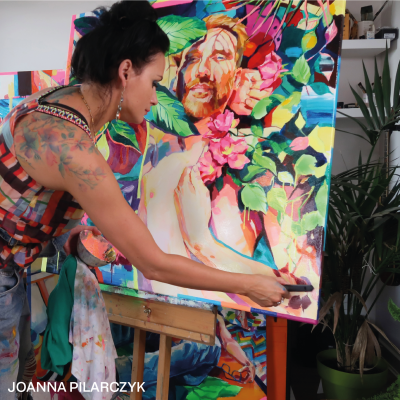

Methodology and Participant Demographics
In order to provide greater context around these findings, here are more details on who we surveyed and the methodology used.
Starting on December 21, 2021 we surveyed 500 Americans who identify as artists, and who also generate income from their art. The survey was conducted online via Pollfish using organic sampling. Learn more about the Pollfish methodology here.

Artists always have to balance the desire to create the art they want, while also making art that collectors wish to buy. Before we go further into how artists are earning revenue from their art, here’s more about our respondents for this survey.
13% earn their living as a full-time artist, while others work “day jobs”
While everyone we surveyed generates some kind of income from their art, only 13.2% are full-time artists. The majority of our respondents (16.6%) are actually employed full-time in non-art day jobs, fitting their creative pursuits around their professional demands.

The majority are working in digital art
Of those artists we surveyed, the majority (23.6%) are working in digital art, followed by mixed media (20.6%). 19% produce paintings, 18.8% sculptures, and 18% drawings.

The top style is abstract
The top styles our respondents work in include abstract (15%), street art (13.8%), and minimalist (13%). Those who replied “other” account for 12.2% of respondents, followed by conceptual at 12%.
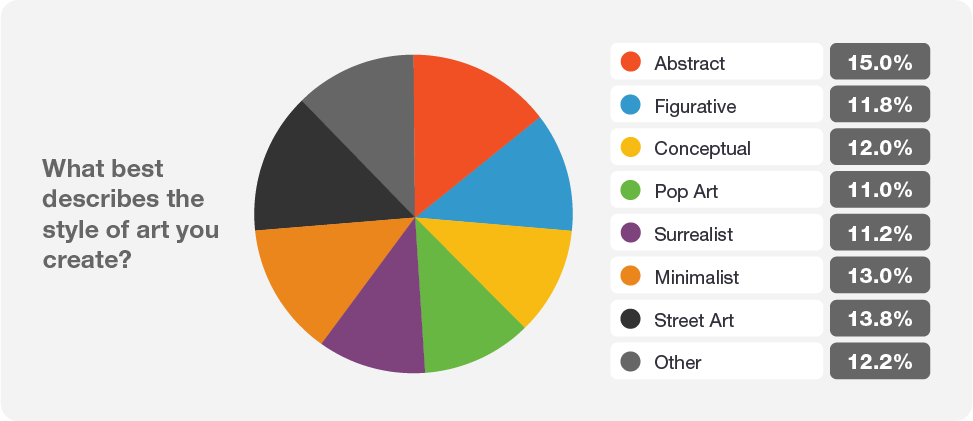
The majority are self-taught artists
The majority of our respondents are self-taught artists (20.8%), followed by those who trained through art classes alone (19%). 17.8% used online courses to learn their craft, and 16.2% went the academic degree route. 11.4% trained through one-on-one mentoring, coaching, or with a private teacher. 14.8% found another path to becoming an artist.

SUMMARY
Now that we know a bit more about our respondents — artists who work across a variety of mediums, mostly self-taught or who have taken classes to learn their practice, and who supplement their art income with a full-time job — let’s examine how they’re putting their art out into the world, how they’re generating income from it, and which new opportunities they’re most excited about.

PART 1
Artist Earnings and Income Streams
While some artists create art for art’s sake, many desire an audience for their work, and want that audience to both appreciate and pay for it. Just how much artists are earning from their work, and how they are doing so, were questions we posed to the group.
Only half have become more financially stable as a result of their art earnings
We discovered that about half (49%) find that income generated from their artwork makes them more financially stable. The other half (51%) are not finding more financial stability from sales of their artworks.

45% earned more than $80,000 last year from their art
Our respondents are evenly spread out across income amounts generated from sales of their art. However, the majority (16.6%) made $120,000 or more in the last year from their art. The next largest segment (15.6%) made between $40,001 and $60,000 from their art, and the third largest segment (15.4%) made between $100,001 and $120,000.
Overall, 44.6% of artists surveyed earned $80,000 or more from their work in the past year.

35% are earning less than ever because of the impact of covid
When it comes to the effects of the pandemic, 34.8% say they’re earning less than ever, possibly due to in-person events and galleries shutting down. 31% say they’re earning more than ever, perhaps due to finding new online and virtual audiences, and 34.2% say COVID has had no impact on their art income.

The majority are selling their works for between $501 and $1,000 each
While our respondents are selling pieces for a variety of prices, the majority (15.8%) are selling works for between $501 and $1,000 each.
However, our respondents are evenly split on selling works for between $2,501 and $5,000 (14.8%), $251 and $500 (14.6%), $1,001 and $2,500 (14.2%), or $5,001 and $10,000 (14.2%). 13.6% are selling their work between $1 and $250, and 12.8% are selling works for $10,001 or more.
Overall, 56% are selling their works for over $1,000 per work.

Top Channels Generating Income
Artists can and should be using a multitude of channels to promote their work, increase their exposure, and connect with those interested in purchasing their art. When it comes to channels generating the most income, our respondents are finding the most return in the following:
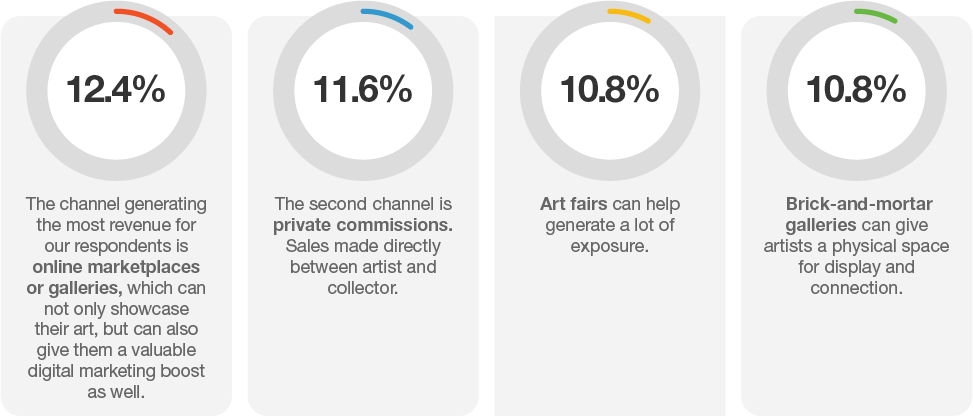
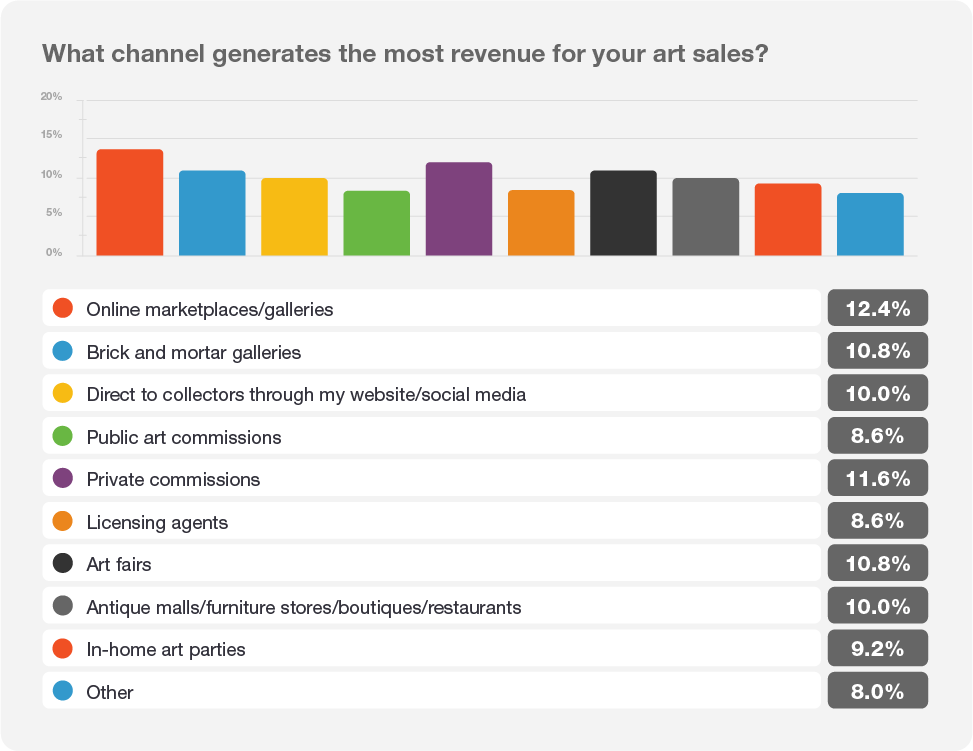
SUMMARY
The respondents to this survey are all making money through the sale of their artwork. But many of them are not generating a livable self-sufficient income.
45% reported that they earned more than $80,000 last year from their art — which means that 55% earned less than that. Similarly, 49% report that they’re more financially stable from the earnings their art generates, leaving 51% who are not earning a stable income from their art.
However, 31% replied that they’re earning more money than ever from their art, despite the pandemic, and 56% are selling works for over $1,000 each — some over $10,000. They’re also finding steady income generation through online marketplaces or galleries, private commissions, art fairs, and brick-and-mortar galleries.
What does this tell us? It’s possible to earn stable income through art sales, as we’ve seen from many of our respondents. However, for those not earning a stable income, opportunities to do so through more savvy pricing and utilizing more diverse channels could give a boost to income generation.
PART 2
Time Spent Creating and Promoting Art
As we saw in the previous section, the majority of our respondents are employed in full-time jobs outside of their artmaking. So when does that leave time for them to actually create their art, not to mention promote it, and run the business side of an artist’s career?
Artists are spending between 31 and 40 hours a week creating art
The majority of our respondents (22.2%) are spending between 31 and 40 hours a week creating art. Of those spending 31 hours or more per week on creating art, nearly half (48.8%) are doing so while working full-time or part-time in another professional capacity
Looking at the remainder of our respondents, 19.2% are spending over 40 hours a week creating art. Other time commitments to art creation include 21.2% spending one to 10 hours, 17.2% spending 11 to 20 hours, and 20.2% spending 21 to 30 hours.

Artists are also spending between 21 and 30 per week promoting their work
When it comes to promoting their work, the majority (21.6%) are spending between 21 and 30 hours per week (the equivalent of a part-time job) promoting their work to collectors. 21.4% are spending less than 10 hours per week.
Of those who spend between 21 and 30 hours per week promoting their artwork, most of them go on to spend an additional 21 to 30 hours just creating.
Those artists that spend 31 hours or more per week creating their art dedicated upwards of 31 hours in promotion — and actually 19.8% of these artists spend more than 40 hours. That’s a lot of time!

Biggest Time Commitments For Artists
As we’ve seen, between creation and promotion, artists are spending a good deal of time on their art, often in addition to part-time or full-time jobs. We drilled down to get additional insights on the business demands of being an artist.
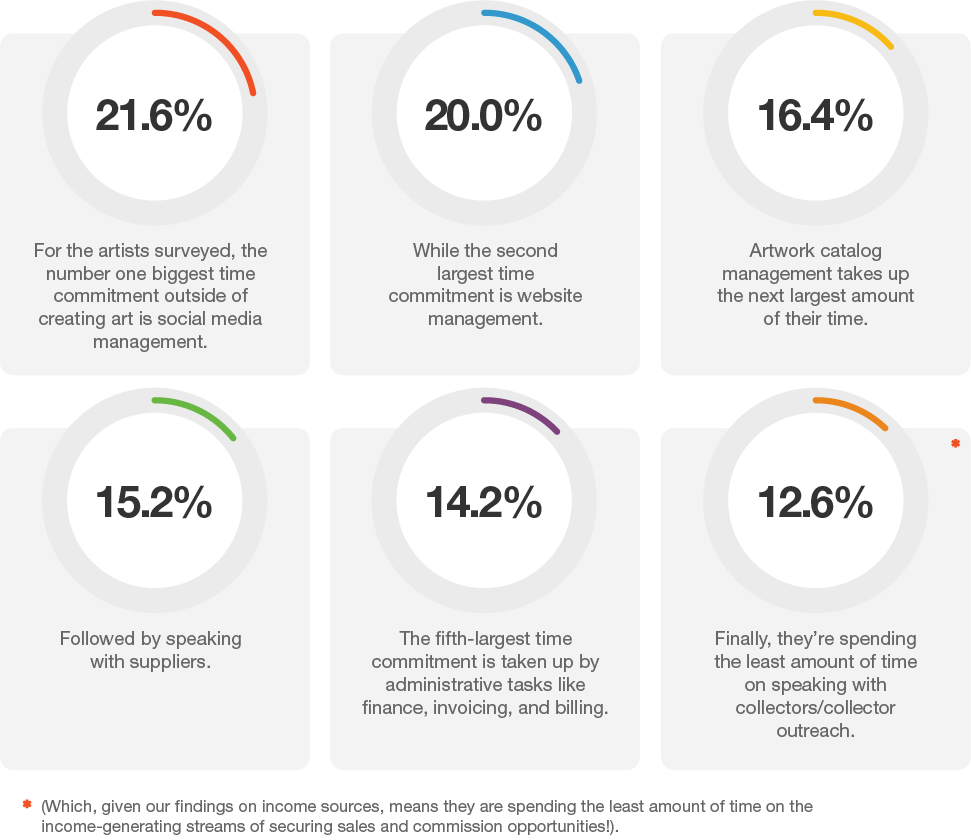
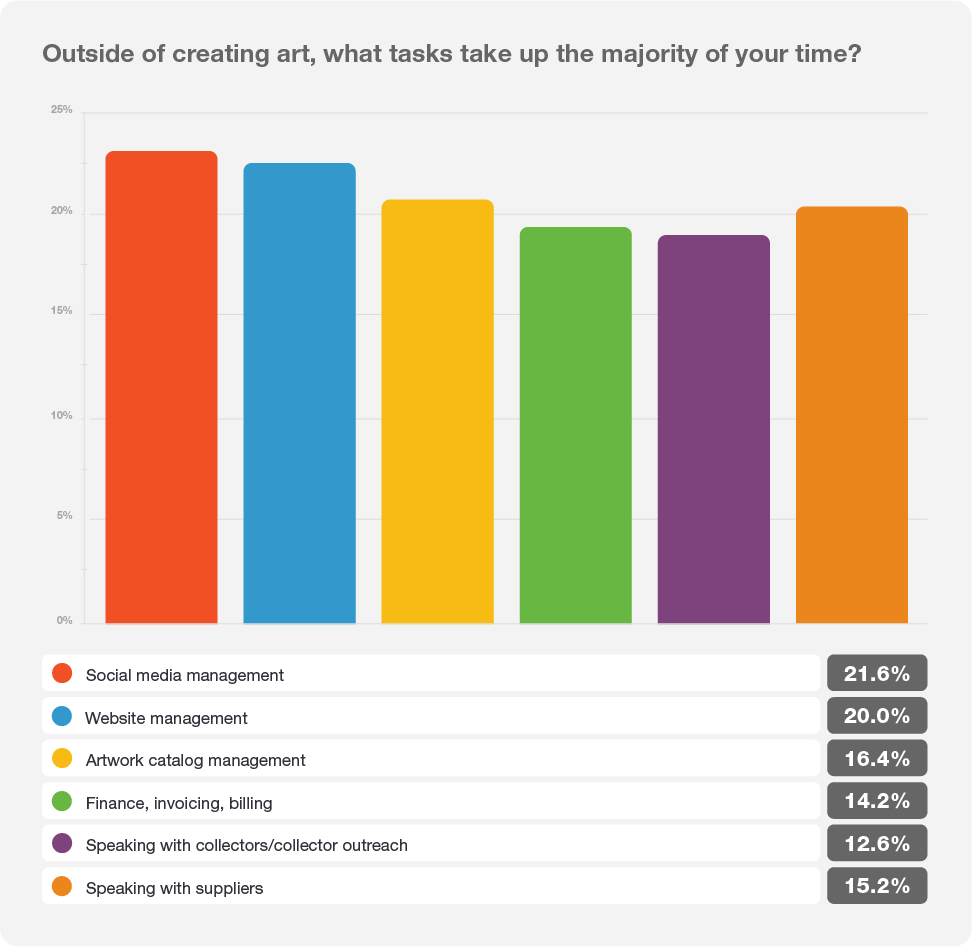
Only half enjoy the business aspects of being an artist
Artists today are also tasked with being their own marketers, managers, and admins. Yet a little over half of respondents (53%) say they enjoy the business aspects of their art. 47%, however, don’t enjoy it.

SUMMARY
Artists are spending a lot of time on making their art — which makes sense. But they’re also spending a significant amount of time promoting their work. We found that the majority of artists are spending between 31 and 40 hours a week creating art, and that they’re also spending an additional 21 to 30 per week marketing it. It’s a massive time commitment on their part, especially considering that many are working other jobs to support themselves.
When it comes to promoting their work, our respondents said they’re spending the most time on social media and website management — a necessary but time-consuming task. They’re also managing their catalog, speaking with suppliers, and busy with general administration tasks.
These findings, of course, beg the question: Are there easier and less time-consuming ways for artists to promote their work? How can galleries and other partners help give them back the time they need to create?
PART 3
Experiences with Galleries and Marketplaces
Art is meant to be seen and appreciated, and artists must showcase their work in some fashion to give art enthusiasts and potential collectors the opportunity to discover them. While social media, websites, and personal online portfolios have given artists more tools to connect with their audience, artists have traditionally gotten their exposure through galleries. We wanted to know more about our respondents’ experiences with working with galleries, both online and physical.
Half of artists have worked with a brick-and-mortar gallery
A little over half of the artists we surveyed (53%) have worked with a brick-and-mortar gallery before, while 47% have not.
In looking at the data further, we found that 115 respondents (23%) have only worked with a brick-and-mortar gallery, while 150 respondents (30%) have worked with both a brick-and-mortar and an online gallery before. 127 respondents (25.4%) have worked with neither.

Only 35% of artists found the brick-and-mortar gallery experience positive
For those who have worked with a brick-and-mortar gallery before, only 34.7% found their experience positive. One-third (33.2%) found their experience somewhat positive, and nearly one-third (32.1%) found their experience to be negative.

Half of artists have worked with an online gallery or marketplace
Similarly, about half of our respondents (51.6%) have worked with an online gallery before, while 48.4% had not.
In looking at the data further, we found that 108 respondents (21.6%) have only worked with an online gallery, while 150 respondents (30%) have worked with both a brick-and-mortar and an online gallery before. 127 respondents (25.4%) have worked with neither

37% of artists found the online gallery experience positive
For those who have worked with an online gallery before, only 37.2% found their experience positive — slightly more than those who have worked with a physical gallery. 29.1% found their experience somewhat positive, and one-third (33.7%) found their experience to be negative.

Artists slightly prefer online galleries over brick-and-mortar galleries
If given the choice, 52.6% say they would prefer to work with an online gallery, only a slight preference over the 47.4% who say they’d prefer to work with a physical gallery.

Top Reasons Artists Prefer A Physical Gallery
Both physical and online galleries can serve to further an artist’s career in different yet complementary ways. Here are the top reasons why an artist may prefer a physical gallery.
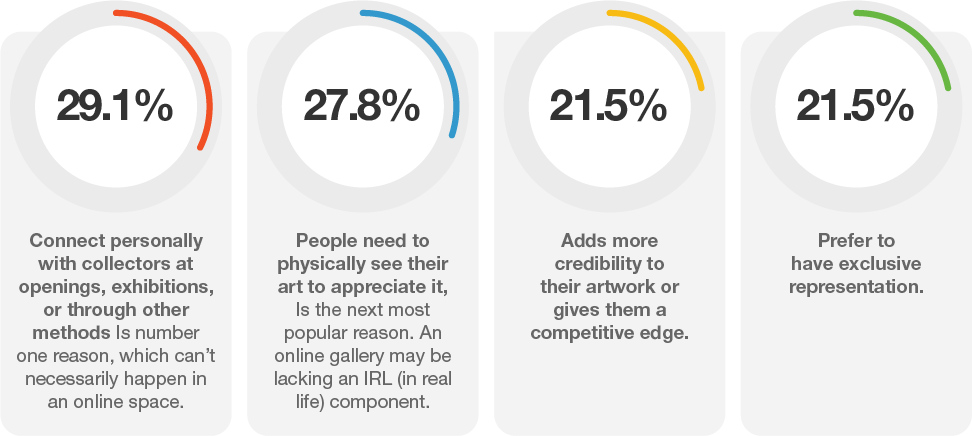

Top Reasons Artists Prefer An Online Gallery
Online galleries can offer opportunities that physical galleries can’t, and should be considered alongside physical galleries for promotion of an artist’s work. Here are the top reasons why an artist may prefer an online gallery.
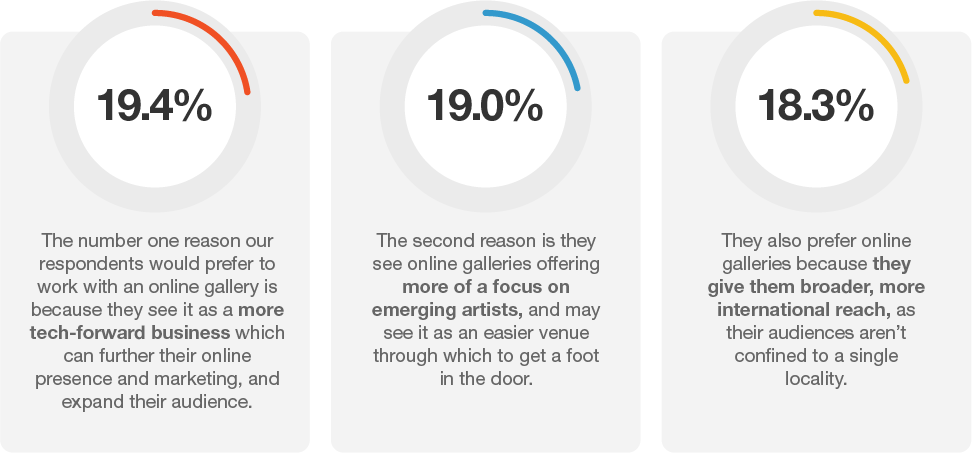
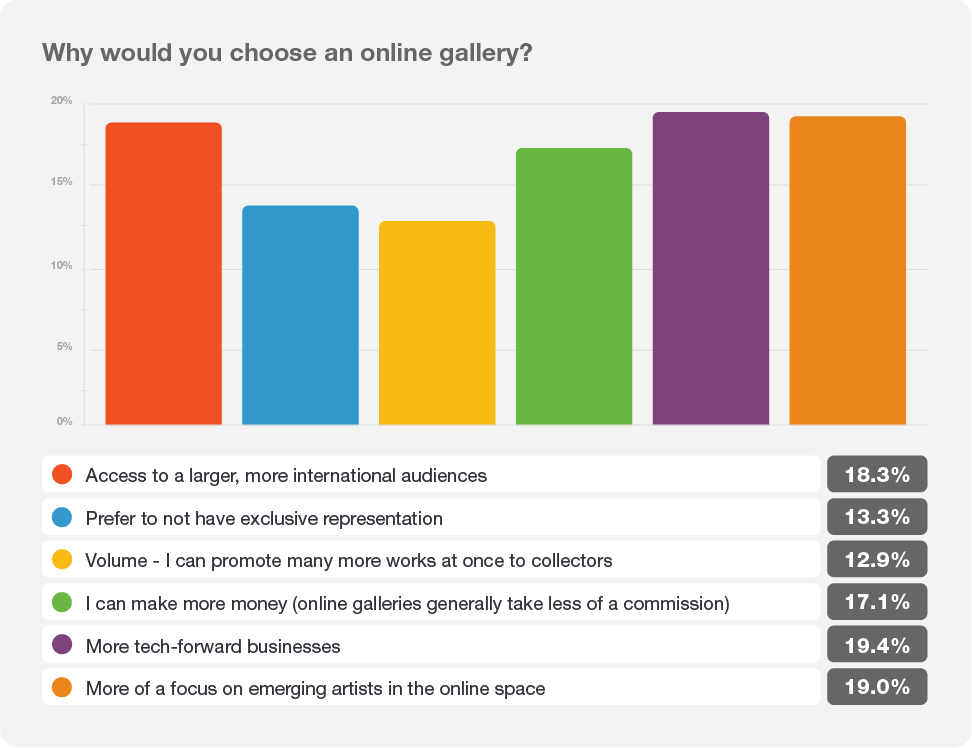
SUMMARY
Artists should always be looking for ways to maximize their exposure to connect with potential collectors. This means utilizing both online and brick-and-mortar galleries, as they can both serve different purposes to further the reach of an artist’s work. Respondents cited that they want to work with a physical gallery, so they can connect with their audience, and so that people can physically see their art. However, respondents enjoy the tech focus of online galleries, and their emphasis on supporting emerging artists.
However, artists aren’t necessarily thrilled with either experience, with only about a third of them having truly positive experiences at one or the other.
As we saw in the data, both physical and online galleries are top channels for generating income for artists. Yet there is ample room for both types of galleries to improve the artist experience.
PART 4
Challenges and Frustrations
Any artist looking to make a living through their craft will be met with challenges — from logistical ones like how to price their work or find hours in the day to create to internal ones like finding inspiration or wondering if they’re truly delivering on their creative vision. We wanted to learn more about what challenges and frustrations artists are struggling with that may be hindering them from creating their best work.
Top Five Biggest Challenges Facing Artists Today
What are some of the biggest everyday challenges our respondents are facing?
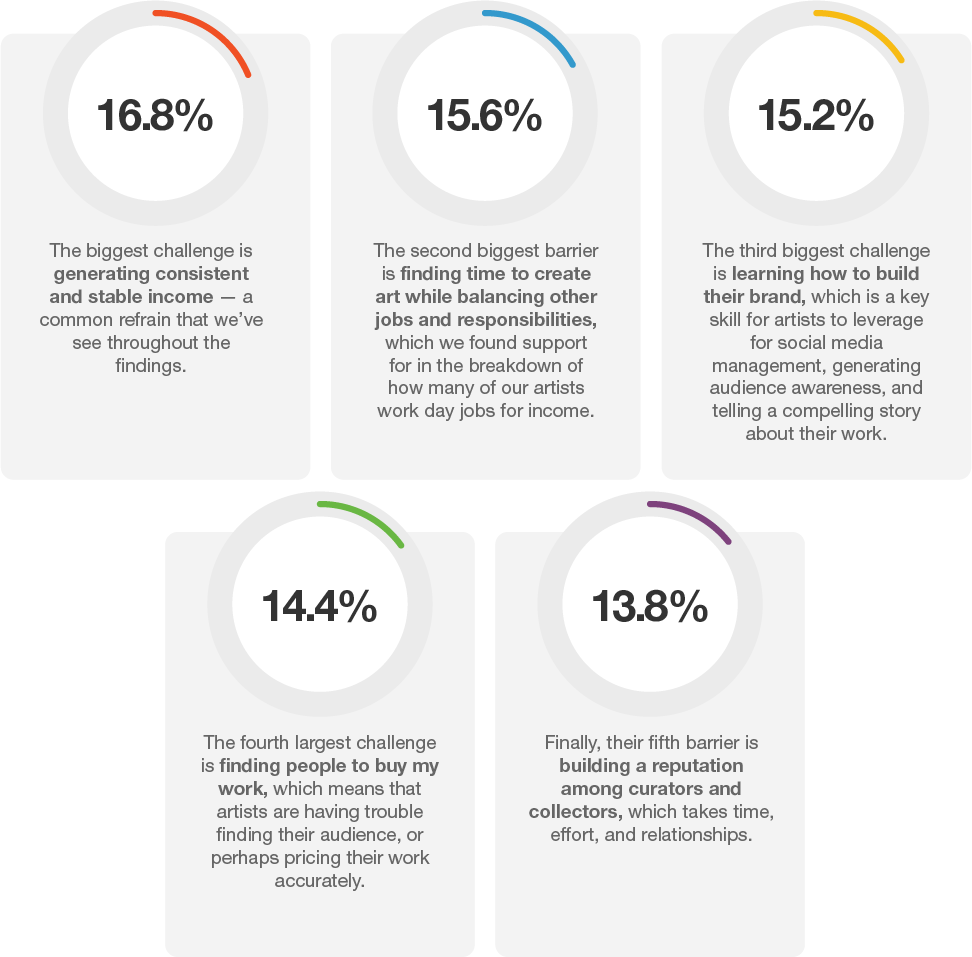
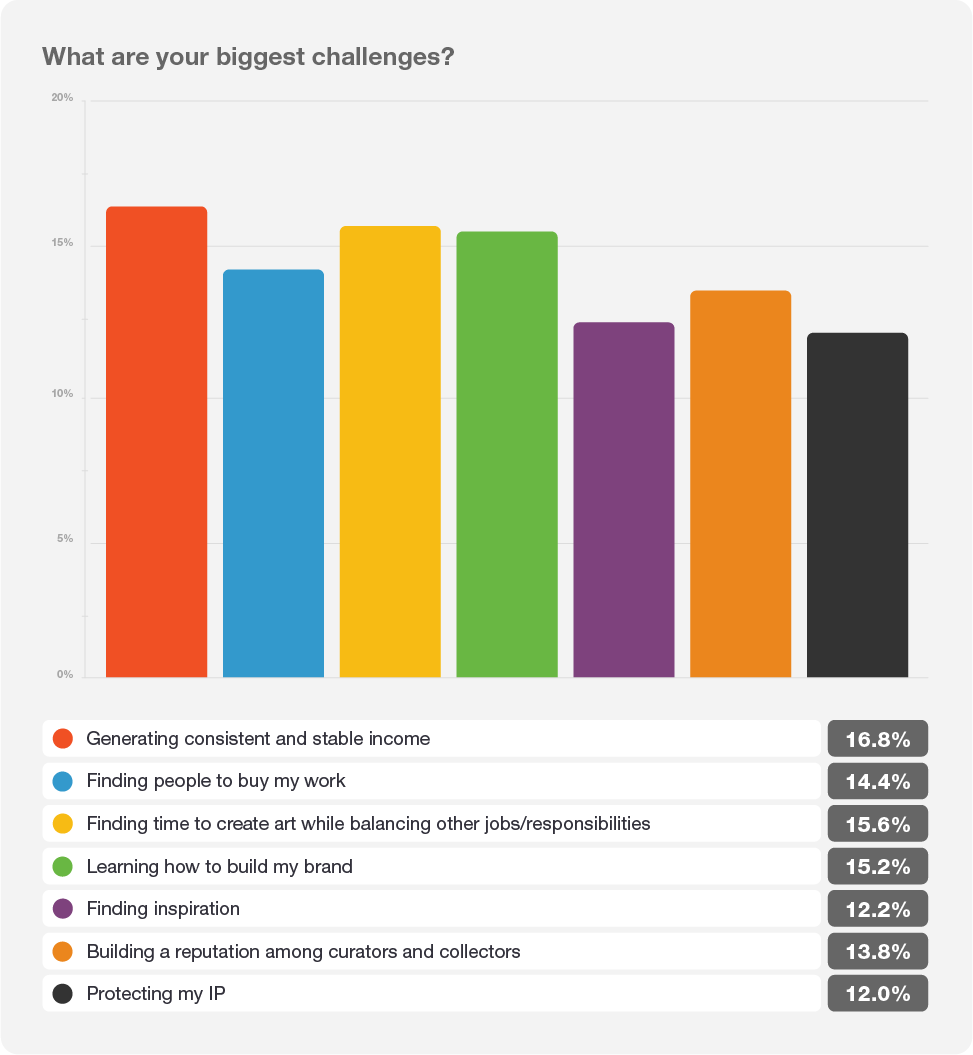
Top Five Frustrations Of Artists Today
Similarly, artists are struggling with other frustrations that may be hindering them from making their best work.
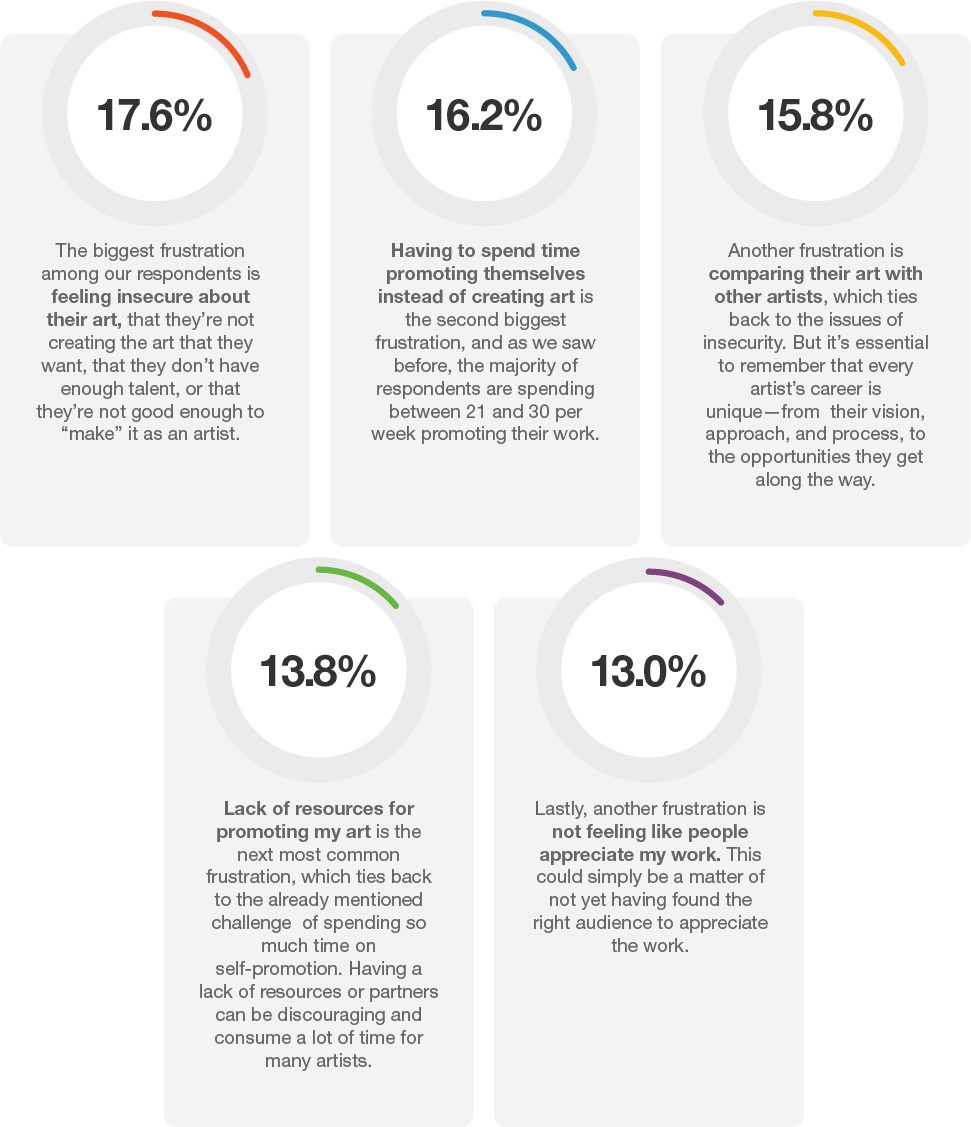
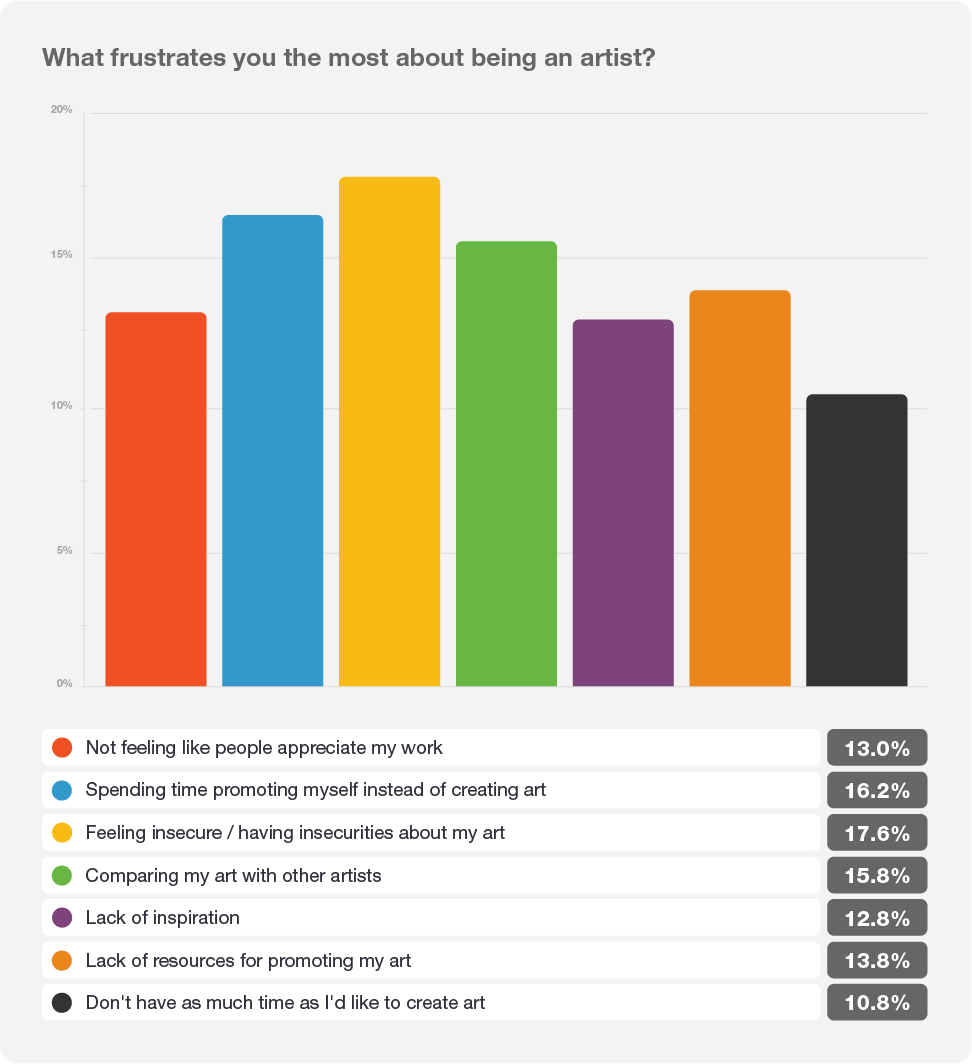
SUMMARY
The biggest challenge to artists today is not just generating income, but having that income be consistent and stable. The volatility in income generated by one’s art practice may be the result of many things — pricing issues, not finding the right audience, hesitancy around partnering with a gallery, or simply not having enough hours left in the week to self-promote.
Many of the artists we polled are frustrated by having to devote time to self-promotion, which to them is time that could be better spent making art. As we saw previously, much of this time is spent on two primary tasks: social media and website management.
However, the biggest frustration — and probably the most common amongst artists — is feeling insecure about their work. Nearly all artists struggle with feeling vulnerable, as art creation takes an inordinate amount of creativity, emotion, inspiration, and soul — and, at the end of the day, many artists wonder if they are good enough to succeed. But there’s always an audience out there somewhere for every artist’s work — it’s just a matter of finding them. There are many ways to do so, especially if artists are willing to stay open to new opportunities and directions. Even niche interests can generate a substantial following online, so if you haven’t met your audience in real life yet, they may be waiting in the virtual space.

PART 5
Digital Art and NFTs
The art world is always evolving as artists seek new themes, new mediums, and new means of expression for their creativity. Today, technological advances are providing new digital tools with which to create, and new channels through which to promote art, connect with collectors, and even get paid. Art NFTs in particular are creating new opportunities for art ownership, income generation, and reaching new audiences. But how do artists feel about these developments?
The majority are excited about the potential of digital art
When asked how they feel about digital art, there was a range of responses. The majority of our artists (36.8%), however, replied that they’re very interested in the idea; they think it’s a true art form, and say they’re very excited about the potential.
31.8% replied that they’re somewhat interested in digital art and believe it has potential, but that they’re still undecided on how to feel about it.
31.4% said that they’re not interested in the idea at all; they feel it’s not a real art form for serious artists and is just a fad.

One-third of respondents have considered creating an NFT
Have our respondents considered creating an art NFT? 32.2% said yes, they have, while 32.4% said they have not. 35.4% replied that they don’t even know what an NFT is.

Three Most Appealing Aspects About Art NFTs
For those who have considered creating NFTs, what was it about the process, the execution, or the results that they found most compelling?
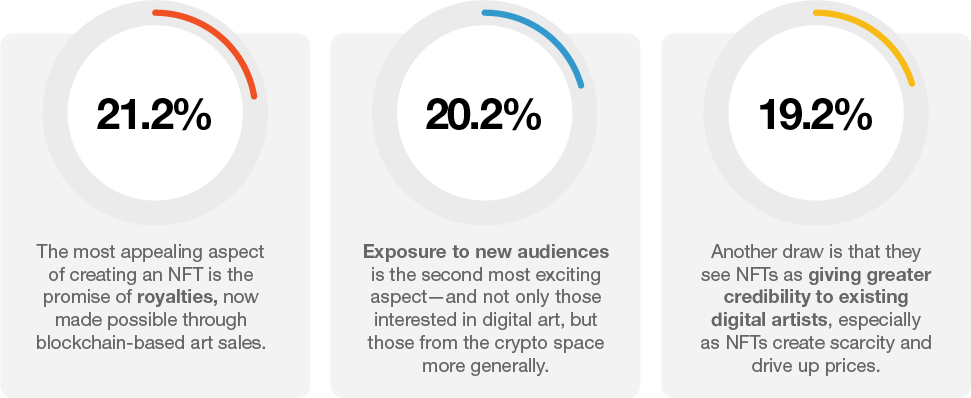

39% have actually created an nft — and 24% want to, but don’t know how to get started
For those who have considered or made an NFT, we wanted to know how far into the process they got. As it turns out, 38.5% have actually created an NFT. 19.9% say that they’re taking an NFT course to learn more about the technology and creation process, and 18% have read some articles online, but that’s all so far.
Nearly a quarter (23.6%) replied that they’re interested in creating one, but don’t know how to get started, signaling a lack of education, resources, and curators in the space.
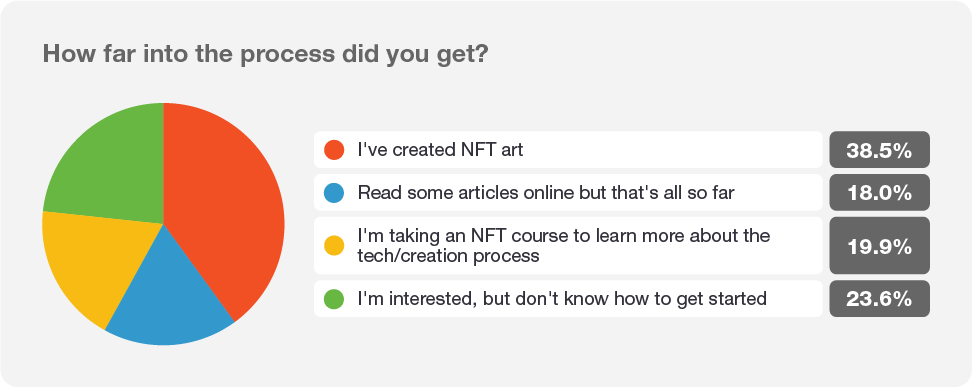
The majority created a digital-only NFT
For those who created an NFT, the majority (38.5%) created a digital-only NFT. However, 32.9% created a physical version and digital version that were sold separately, and 28.6% created a physical version and digital version that were sold as a bundle.
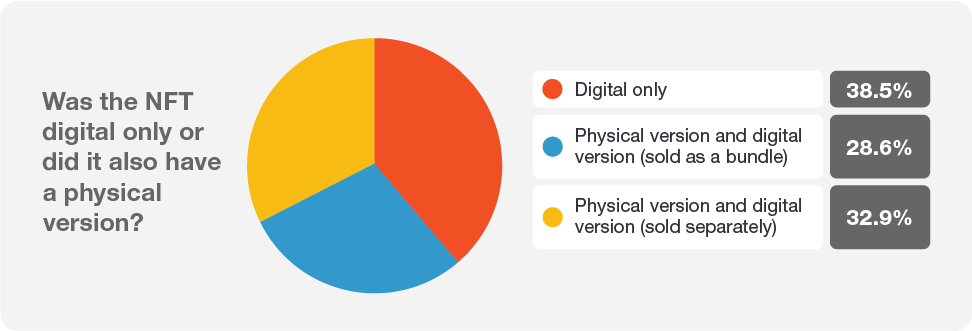
Only 54% were able to sell their art NFT
For those who created an NFT, only half (54%) were able to sell it. This could be due to some of the challenges explored below, like difficulty in pricing, identifying the right platform to use, or promoting their NFT to buyers.

Three Biggest Challenges When Creating Art NFTs
Because creating and selling art NFTs require a set of considerations that are different from traditional art, we wanted to hear from respondents who have been through the process about some of the challenges they faced.
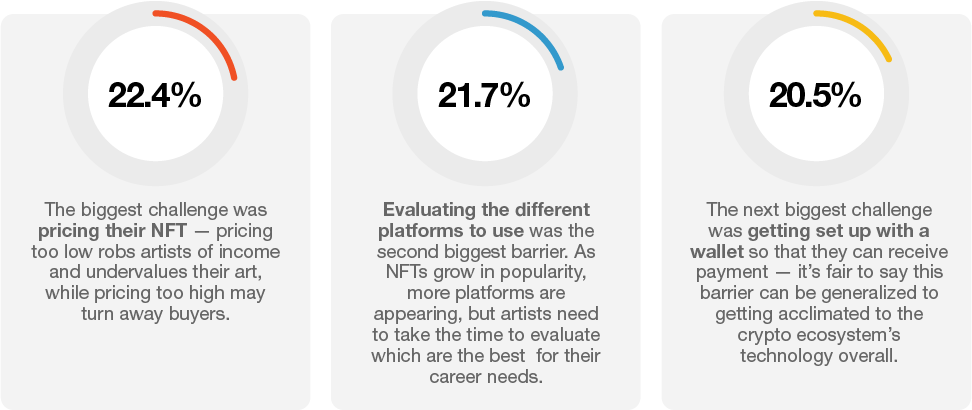

Top Five Best Practices For Artists Creating NFTs
We saw the challenges that our artists faced when creating NFTs. Now that they’ve been through the process, what best practices would they share with others?
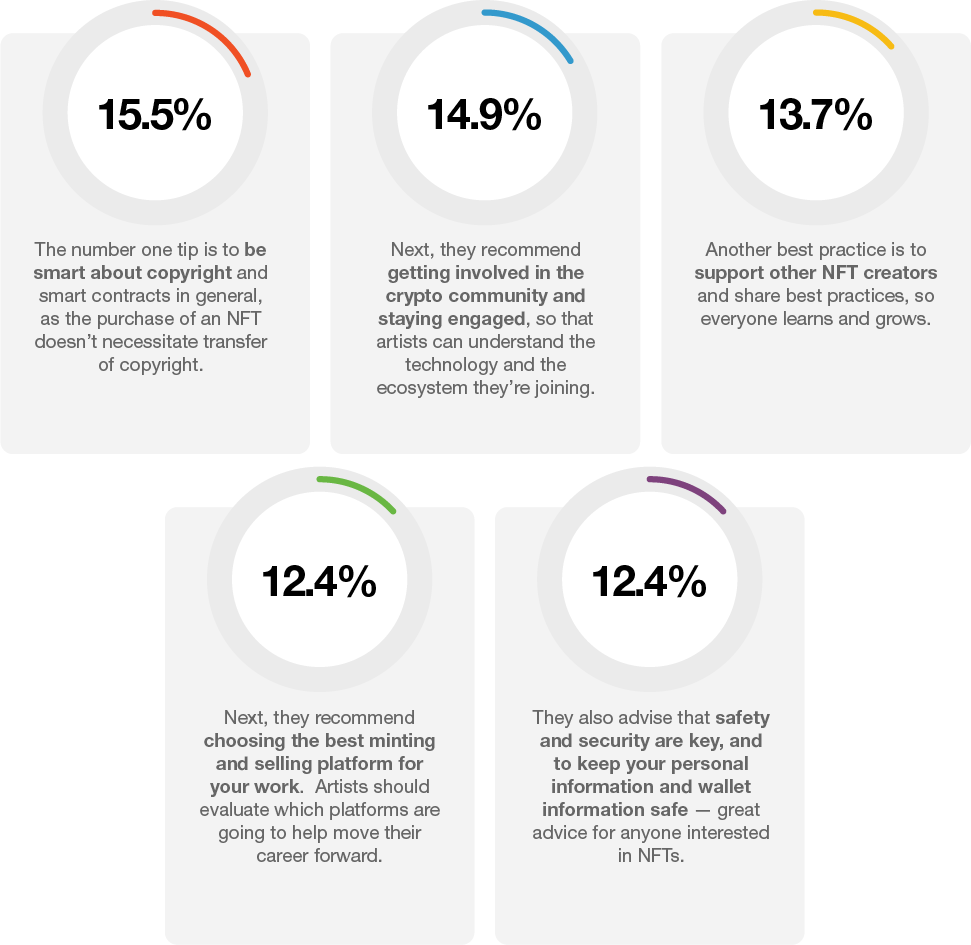
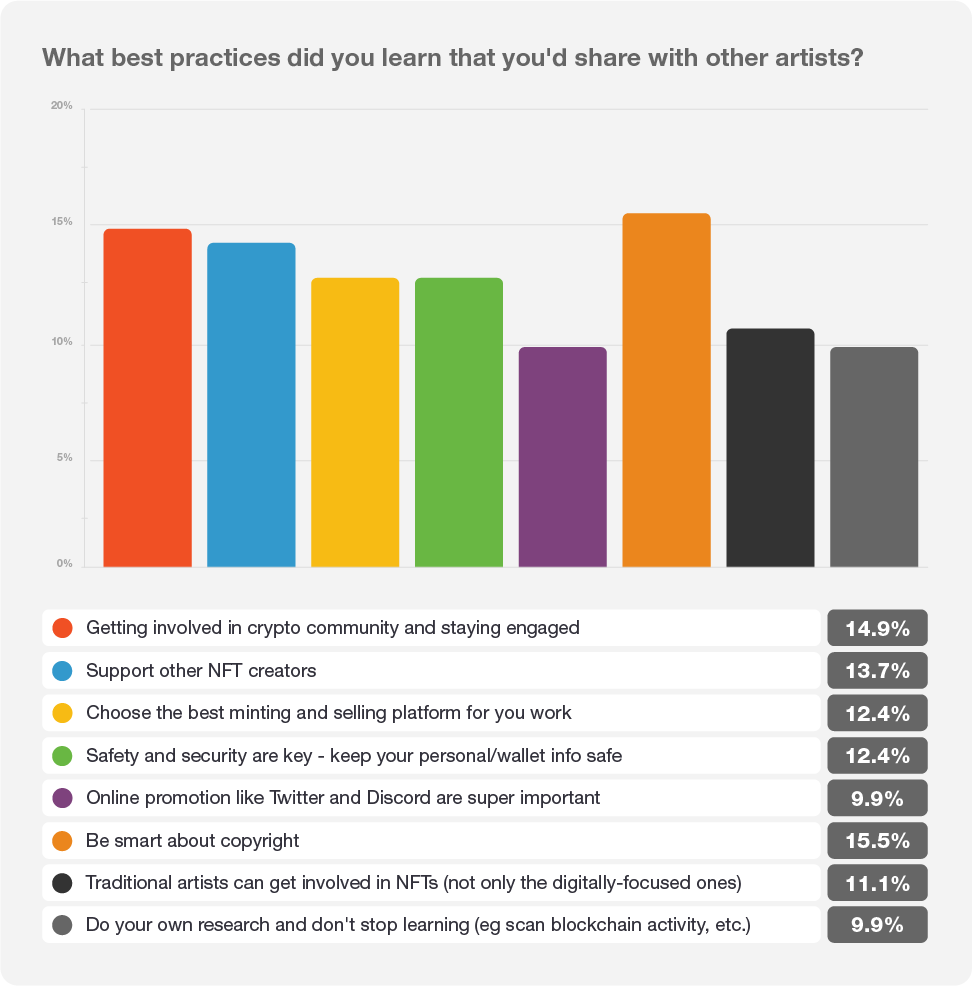
Top Five Barriers To Creating NFTs
Many of our respondents hadn’t yet created NFTs, didn’t know what they are, or were generally hesitant about digital art, so we wanted to learn why. Here’s what we found:
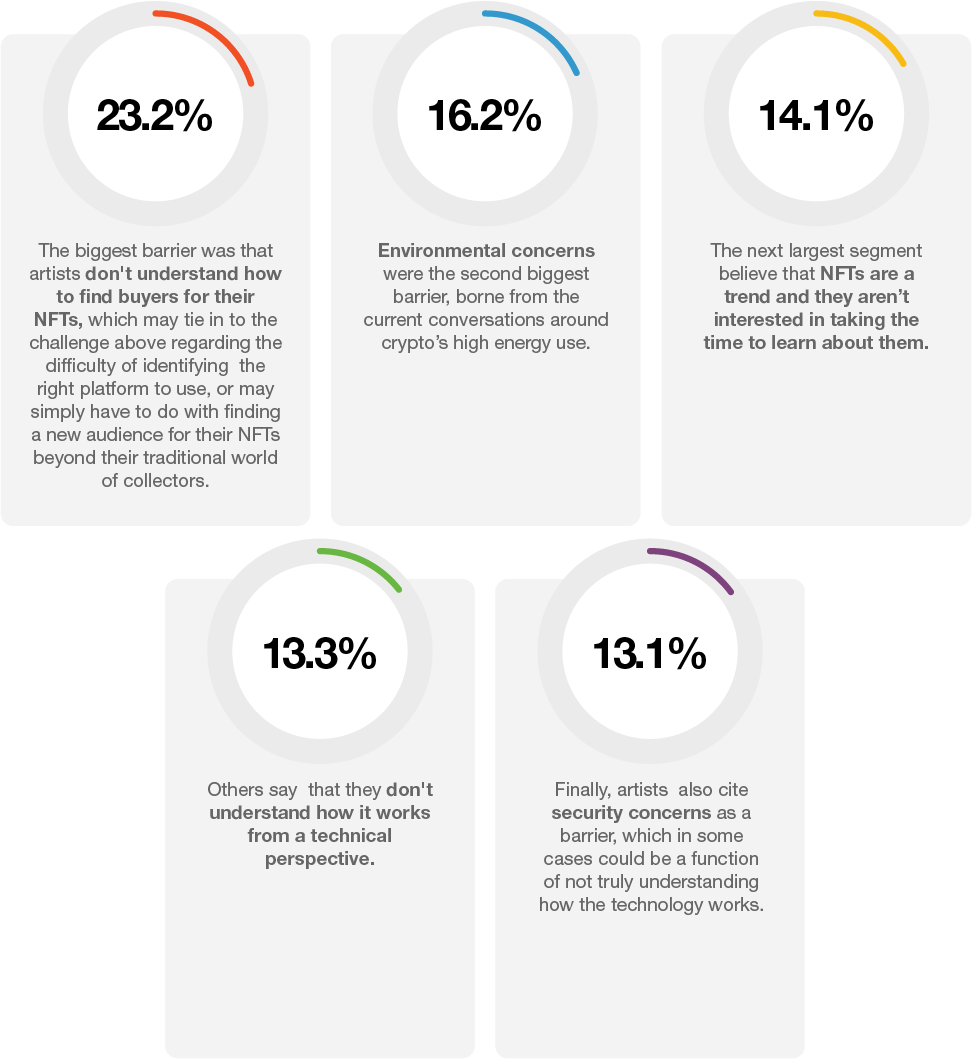
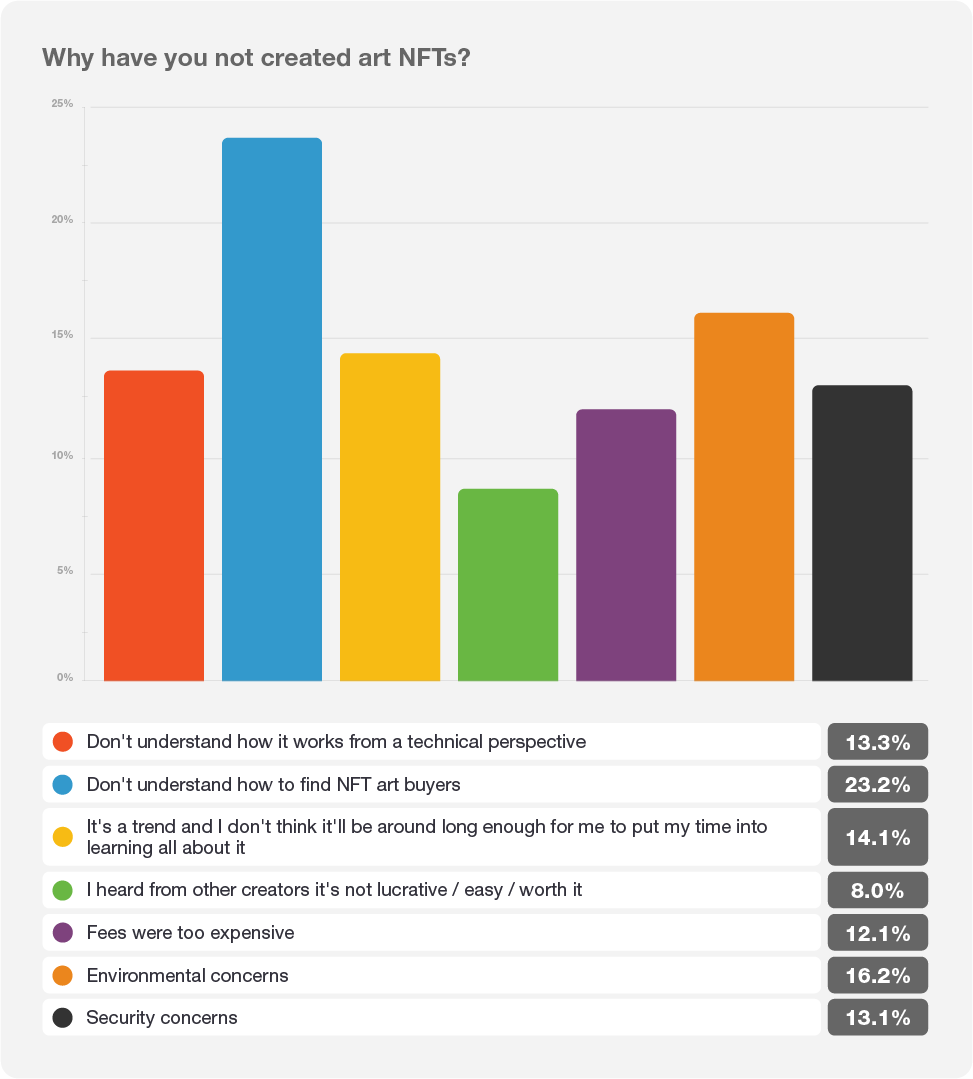
Five Changes That Would Increase Adoption
What would it take for those reluctant to create an NFT to pursue it? Here’s what artists say needs to change in the industry to increase adoption.
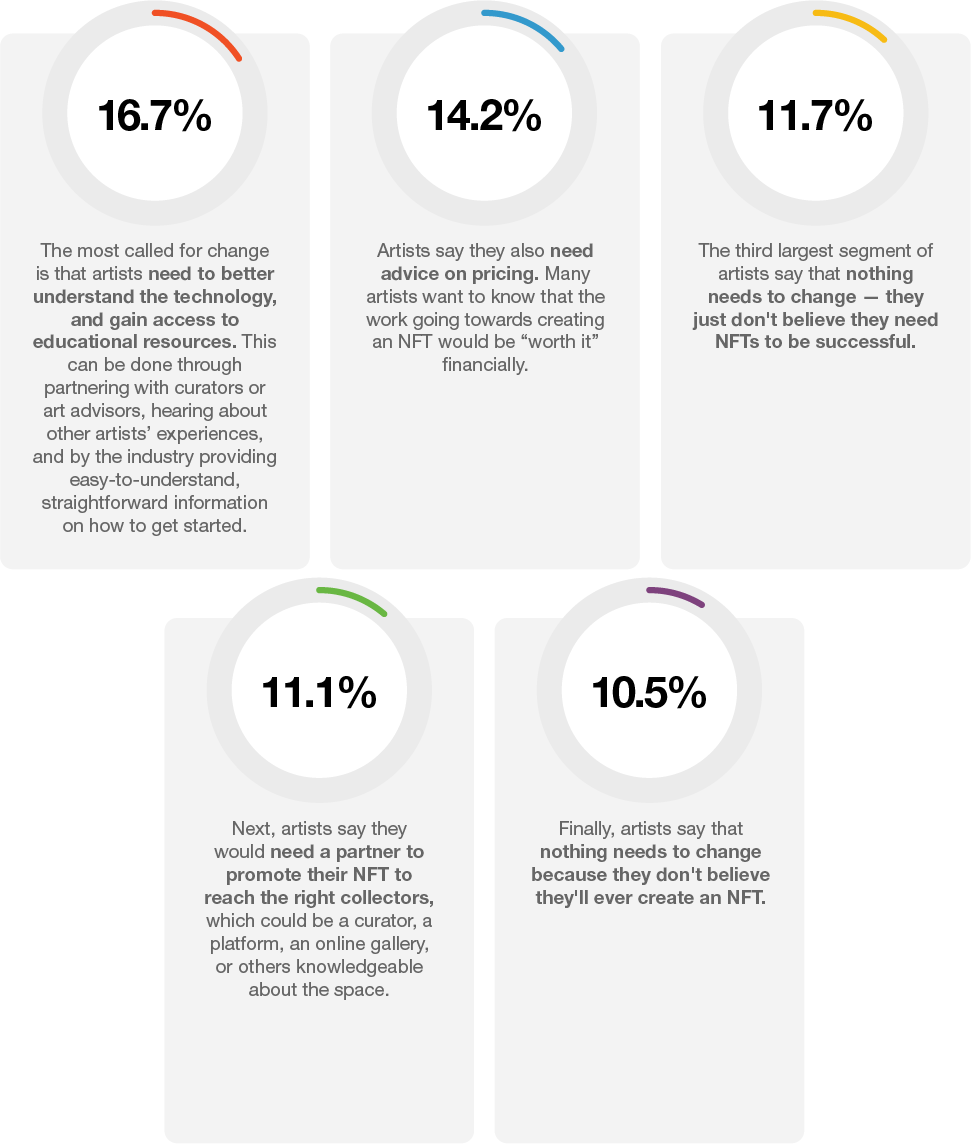
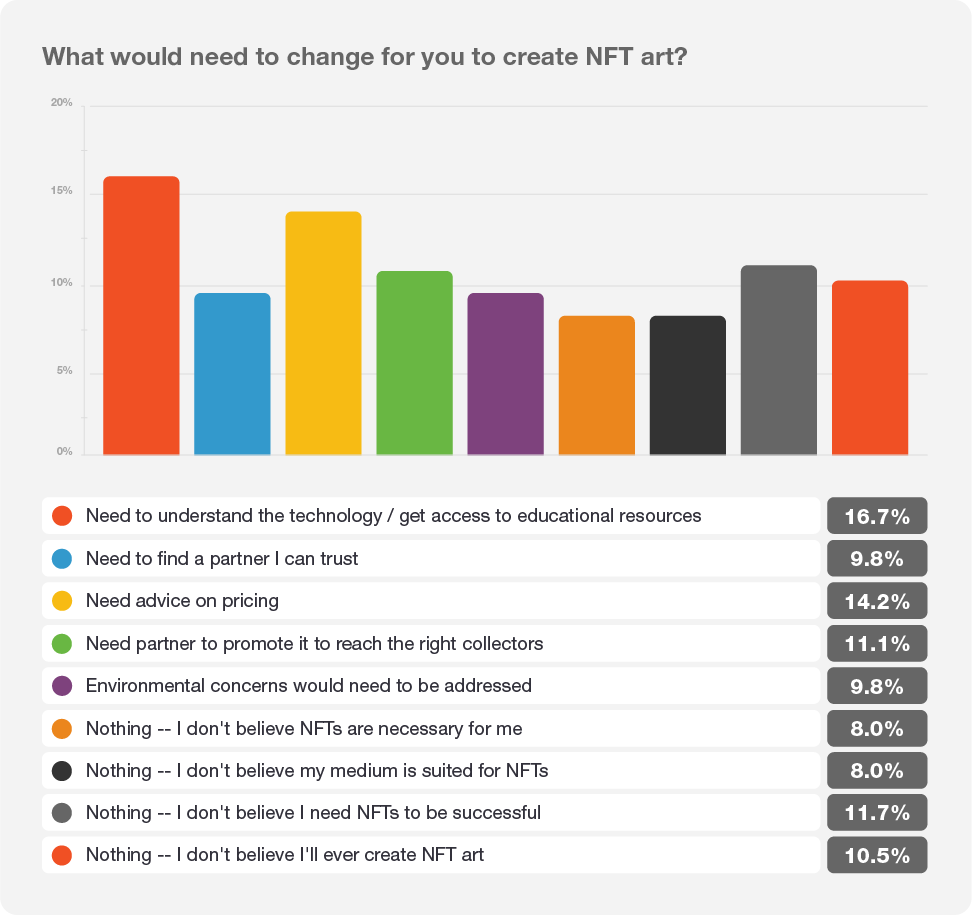
54% believe that the digital art market will become larger than the traditional art market
In five years’ time, a little over half (54.2%) of our respondents believe that the digital art market will surpass the traditional art market. However, 45.8% believe the traditional art market will continue to be first.

SUMMARY
Digital innovation, online galleries, and NFT minting are opening up avenues for artists to find new audiences and to increase income. We found that the majority of artists are excited about the potential of digital art, and in fact, over half believe that the digital art market will become larger than the traditional art market.
We discovered, too, that one-third of respondents have considered creating an NFT, and 39% of those artists actually went on to create one. The most appealing aspects for them to create an NFT were the ability to generate royalties, getting exposure to new audiences, and seeing NFTs as giving greater credibility to existing digital artists — all which can help augment their income.
Despite the enthusiasm of some, 35.4% replied that they don’t know what an NFT is, and 24% of those who have considered creating an NFT just don’t know how to get started. They’re also reluctant to enter the space because they don’t understand how to find buyers for their NFT, they have environmental concerns around crypto, and they feel that NFTs are a passing trend.
NFTs are providing unique and new opportunities for artists, yet as we’re seeing here, the industry needs to continue to educate artists on the benefits of creating NFTs, share best practices, help get artists acclimated to the crypto world, and show the advantages and practical gains NFTs have already brought to artists and their careers.
PART 6
Artist Income Outlook
Finally, with all the aforementioned opportunities and challenges, we wanted to know how hopeful artists are when it comes to income generation in the future.
52% expect to make more from their art income in 2022 than 2021
About half of our respondents (51.8%) are confident that they’ll be able to generate more income from their art in 2022 than they did in 2021. However, 48.2% don’t believe they will.

65% believe it’s possible to, or already are, earning 100% of their income from their art
When asked if they believe it’s possible to quit their non-art employment and generate 100% of their income from their art, 34.6% said that yes, they do believe it’s possible. Additionally, another 35% said that they already create 100% of their income from art. Only 30.4% felt that it wouldn’t ever be possible.
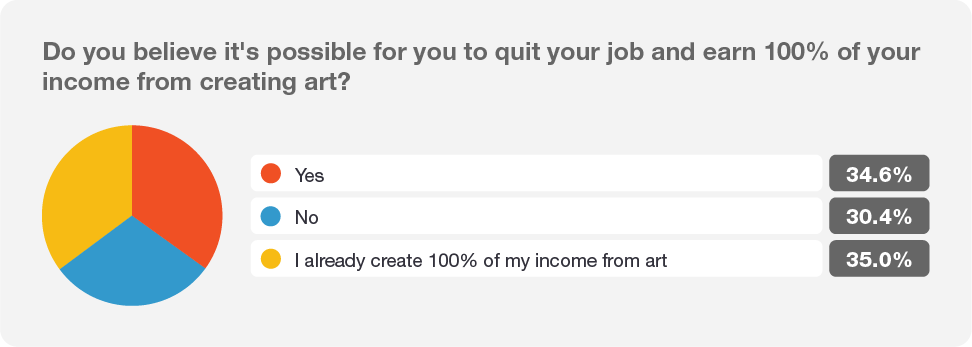
SUMMARY
The findings here come full circle: some artists have discovered the path to steady and stable income, yet many are still seeking the means to get there. In many cases, this requires finding new audiences, increasing exposure — especially through online channels — and developing new ways to generate income, for example through minting art NFTs.
PART 7
From the Artists’ Eyes
We asked artists from all over the world: “What do you wish others knew about artists?”
Many have conflicting points of view, demonstrating the sheer diversity of experience and opportunities among contemporary artists.
Here’s what they had to say.
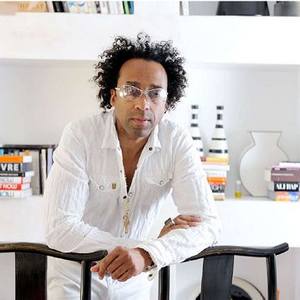
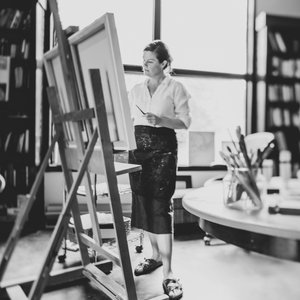

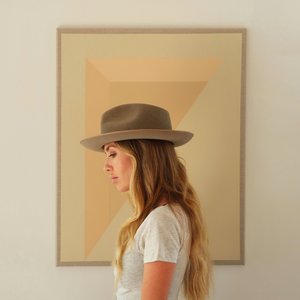



PART 8
Top Takeaways for Artists
Artists will always have the passion to create. But they need to be able to earn a living from their work, too.
As we found, there are a fair amount of artists who are making money from their art, but not enough to make a sustainable living solely from art sales. They’re working day jobs while also putting in the equivalent of a full-time job creating and promoting their art — and most of the latter is being spent on digital marketing. Many have tried working with galleries, yet their experiences with them have been mixed. And many haven’t yet turned to NFTs as another source of viable income.
However, our findings demonstrate that there are ways for artists to make a better living through their art and discover and reach new audiences.
Optimizing time spent on digital marketing by working with online galleries
As we saw in the above section, artists are spending much of their time outside of art creation on social media and website management. As an artist today, it’s essential to know how to efficiently and effectively utilize social media and other digital marketing approaches to build your audience, brand, and reputation. Working with an online gallery can help, as their curators and marketing professionals can help boost your work through social media, paid advertising, email, and, for more established galleries, through website and search ranking, more advertising spend, and better PR. This can give artists back time to create.
Utilize both physical and online galleries
Working with physical and online galleries shouldn’t be an either/or, but a both/and, as brick-and-mortar and online sales complement, not cannibalize, each other. Artists should consider using both channels to sell their work, giving them more options and opportunities to grow their reputation, reach a much larger, more global audience, and increase the ability to make a living from their art. Many online galleries also have real world components to them, such as art fairs, that can contribute to an artist’s overall exposure.
Price your work consistently and accurately
One of the biggest challenges to artists is pricing your artwork accurately — and pricing it inaccurately could cost sales and needed income. As you look to price your work, consider its medium, size, the collector demand, your reputation, whether the work is unique or editioned, and other unique aspects. Always factor in the time and labor that went into making your artwork, too. If you’re unsure where to start, or have had challenges pricing in the past, a curator or art advisor can also help guide you on the best pricing for your works as well.
Find an audience by telling your story
As you begin to leverage digital marketing and online tools to promote your work and find your audience, you will need to learn how to write and talk about your work. Collectors want to connect not only with the artwork, but also with the artist behind that work. That means sharing your artistic process and inspiration, and learning how to tell your story authentically. Mastering this will make self-promotion on social media much easier — whether it be through writing posts, sharing videos, or going live through IG stories, Twitter Spaces, Discord, and other interactive platforms — and can help you build confidence in your art to combat feelings of insecurity.
Creating NFTs to diversify income and audience
Finally, artists can find new audiences and income by being open to new mediums and means of expression, especially in the realm of digital art. Creating NFTs could be a valuable way to build your career, even if you’re not a digital artist — many artists working with a physical medium like sculpture or photography, or something more intangible like performance art, can also partake. NFTs hold the promise of new income streams and royalties, and might expose you to audiences you never thought you’d have.
SUMMARY
Artists today have more options than ever for income generation—from working with traditional galleries and engaging with audiences and collectors through social media to showcasing their work in online galleries and utilizing new technologies like NFTs to create scarcity and interest. The more artists can become aware of their career opportunities, the more we hope to see the answer to “Is it possible to earn 100% of your income from your art?” be a “Yes” for every artist.
